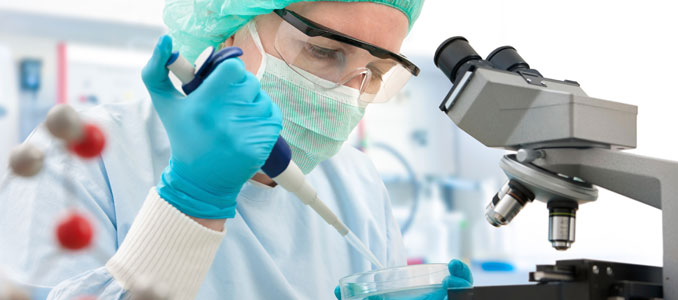Blood Testing For HGH Deficiency
When there is a suspicion that adult human growth hormone (GH) deficiency is present, the doctor will order blood HGH testing to be performed. This is the only viable method of determining if the level of GH being secreted by the pituitary gland is less than what the body needs in order to thrive.
Before HGH injections can be authorized for use, a human growth hormone blood test must be performed. Unlike many other medical conditions that require invasive or lengthy diagnostic procedures, this blood analysis takes only a few minutes of time at the laboratory to have a specimen collected by a lab technician.
A medical advisor at National HRT® will arrange for the appointment at a local lab. This procedure does not replace the required physical examination and medical history form that must also be filled out. The diagnostic assessment is a three-part process that must be completed before HGH therapy can be authorized for use.
Blood Tests for Growth Hormone Deficiency
Making a proper diagnosis of age-related growth hormone deficiency starts with taking a complete medical history and doing a physical exam. After that, if your doctor suspects that you might have a growth hormone deficiency, they will schedule one or more blood tests to determine the extent of HGH deficiency.
The blood tests for growth hormone deficiency include:
- Binding protein levels (IGF-I and IGFBP-3) blood tests to show whether the growth problem is caused by the pituitary gland
- Blood tests to measure the amount of growth hormone levels in the blood
- Blood tests to measure other levels of hormones the pituitary gland produces
- GHRH-arginine test
- Growth hormone stimulation test
- Insulin tolerance test
Other Exams and Tests to Diagnose Growth Hormone Deficiency
In addition to the various blood tests mentioned above, doctors use several other tests to diagnose growth hormone deficiency. These include:
- A dual-energy x-ray absorptiometry (DXA) scan measures your bone density.
- An MRI of the brain may be taken so your doctor can see the pituitary gland and hypothalamus.
- Hand x-rays (typically of the left hand) can also help show your doctor your bones. The shape and size of bones change as a healthy person grows. Your doctor can see bone abnormalities with this x-ray.
- X-rays of the head can show any problems with the bone growth of your skull.
Are the HGH Tests Reliable?
Hormone replacement specialists know how to test for HGH deficiency in adults. The actual measurement of growth hormone levels will not work because they fluctuate widely throughout the course of the day due to the nature of their pulsatile bursts. GH enters and exits the bloodstream at a rapid pace making it unreliable to use as a marker of deficiency.
Instead, doctors check IGF- 1 levels. Insulin Growth Factor 1 is a hormone that is secreted based on the amount of GH that the liver receives each day. IGF-1 is a mediator of the effects of growth hormone, and its level in the bloodstream remains stable throughout the day.
This marker is used to help doctors determine GH deficiency in adults, as well as the dosage of HGH to prescribe based on the level of hormonal decline.
Testing Procedure
The IGF-1 human growth hormone test for GH deficiency will be performed by a lab technician. This procedure takes only a few minutes for the vials of blood to be collected.
Here are the steps that can be expected once taken back into the collection room:
- You will be asked to check the personal information provided (name, date of birth, address).
- The technician may look at both arms to find an appropriate vein – you can request a specific arm if desired.
- A tourniquet (large rubber band) will be tied around the upper arm.
- An alcohol prep wipe will clean the area to be used.
- A needle will be inserted into the vein, and a few vials of blood will be collected.
- The needle will be removed, and a piece of gauze and bandage will be placed on the site.
- Leave the bandage on for a few hours.
Those are the simple steps for how to test HGH levels. Once this has been completed, you are free to proceed with your daily schedule.
What is the Better Time for Testing?
The best time for testing HGH levels with the IGF-1 panel is first thing in the morning before anything has been consumed. Nothing is to be eaten or drank after midnight of the evening before the appointment at the lab. Food and beverages can interfere with accurate readings, and since other blood markers will also be checked, it is essential to get a clear view of what is going on inside the body.
In order to simplify the process of receiving the HGH tests and not have people go long periods of time without food or drink, the appointments are typically scheduled for early in the morning, with most labs opening before or around 8 am.
How to Prepare for the Test
There is very little preparation necessary for human growth hormone testing. We do recommend that you eat a well-rounded diet the day before the test, avoiding excessive sugar, caffeine, and fried or fatty foods.
Nothing is to be consumed by mouth after midnight of the evening before the testing for HGH levels. Since there are some medications that can affect the results, please speak with your medical advisor about any prescription drugs you are taking, as well as any vitamin supplements that are also taken daily.
Relax and get a good night’s sleep, if possible. Some people find this step difficult as insomnia is one of the symptoms associated with GH deficiency.
What Does the Result Mean?
The HGH blood test will show if a person is producing an adequate supply of Insulin Growth Factor 1 which is in direct correlation with the amount of growth hormone that is being produced. If the reading comes back low, and symptoms associated with low GH levels are also present, a diagnosis of growth hormone deficiency will be provided.
This will allow for the calculation of the appropriate amount of HGH to prescribe.
Those who are not shown to have this decline will be provided with information about any other possible causes for the changes in their bodies, along with recommendations, if necessary, to other types of medical specialists.
The IGF-1 results will be used, along with information gathered from the physical exam and medical history report to determine the appropriate course of treatment.
What Do the Results of Your HGH Test Mean
Our doctors use the IGF-1 human growth hormone test to detect growth hormone deficiency or growth hormone test that measures the amount of growth hormone in the blood.
If the IGF-1 test is used, and your IGF-1 level comes back low, and symptoms associated with low HGH levels are also present, a diagnosis of growth hormone deficiency will be provided.
Results of IGF-1 are given in nanograms per milliliter (ng/mL) and vary by age.
| Adult Males | Adult Females | ||
|---|---|---|---|
|
Age |
ng/mL |
Age |
ng/mL |
|
18 years |
109-527 |
18 years |
114-493 |
|
19 years |
104-484 |
19 years |
105-441 |
|
20 years |
98-443 |
20 years |
97-398 |
|
21-25 years |
83-344 |
21-25 years |
84-323 |
|
26-30 years |
75-275 |
26-30 years |
77-271 |
|
31-35 years |
71-241 |
31-35 years |
73-244 |
|
36-40 years |
69-226 |
36-40 years |
68-225 |
|
41-45 years |
64-210 |
41-45 years |
62-205 |
|
46-50 years |
59-201 |
46-50 years |
56-194 |
|
51-55 years |
56-201 |
51-55 years |
53-191 |
|
56-60 years |
51-194 |
56-60 years |
45-173 |
|
61-65 years |
47-191 |
61-65 years |
41-168 |
|
66-70 years |
46-195 |
66-70 years |
39-168 |
|
71-75 years |
42-187 |
71-75 years |
36-166 |
|
76-80 years |
39-184 |
76-80 years |
35-168 |
|
80-85 years |
37-182 |
80-85 years |
35-179 |
|
85-90 years |
35-182 |
85-90 years |
33-179 |
Source: Mayo Medical Laboratories
If an HGH blood test is given, and your HGH level comes back low, and symptoms associated with low HGH levels are also present, a diagnosis of growth hormone deficiency will be provided.
Results of an HGH blood level test are given in nanograms per milliliter (ng/mL) or picomoles per liter (pmol/L).
The normal ranges for HGH level for adult men and women typically are:
- For adult males — 0.4 to 10 nanograms per milliliter (ng/mL), or 18 to 44 picomoles per liter (pmol/L)
- For adult females — 1 to 14 ng/mL, or 44 to 616 pmol/L
Now that you know a little bit more about HGH blood tests, why not contact us and find out more about the many life-changing benefits of growth hormone therapy.




